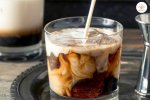duyfpot
Sơ cấp
- 18/4/24
- 0
- 0
- 0
- 20
Discover how to master Kyoto-style slow drip coffee brewing at home with our comprehensive guide. Learn about equipment, brewing methods, and expert tips to unlock the full flavor potential of this unique cold brew method.
– Choice of paper or metal coffee filter
– 50 g – 70 g of premium coffee beans
– Reliable coffee grinder
– Accurate coffee scale
– Fresh water
– Ice
How to Grind Coffee for Slow Drip Brewing:
Utilize a burr grinder to grind the coffee beans, ensuring consistent results. Aim for a medium grind size, similar to what you’d use for an automatic drip coffee machine.
If you lack a burr grinder, avoid using a blade spice grinder, as it yields uneven grinds. Instead, consider purchasing pre-ground coffee from a reputable source or seeking assistance from a local coffee shop.
Expert Tip: Opt for freshly ground coffee beans whenever possible, ensuring optimal flavor.
When it comes to Kyoto-style drip coffee, you have the option to use either a paper or metal filter, each imparting a slightly different flavor to your brew. Paper filters tend to produce a cleaner, lighter-bodied cup similar to pour-over coffee, while metal filters allow more oils and fines to pass through, resulting in a heavier-bodied cup akin to French press coffee.
ExperTip: If you opt for a paper filter, especially an unbleached one, remember to rinse it with hot water beforehand to eliminate any potential paper taste.
Expert Tip: For optimal results, use cold, filtered water preferably stored in a refrigerator. However, room temperature tap water works fine, especially when combined with ice.
The brew time varies based on factors such as coffee quantity, drip rate, brewer design, and water-to-coffee ratio. While some brewers may complete the process in as little as 4 hours, others may take up to 24 hours. Regardless of the duration, patience is essential for achieving authentic Kyoto-style slow drip coffee.
While this brewing method is largely hands-off, occasional monitoring to ensure consistent drip rates is recommended.
Expert Tip: Craving an iced coffee without the lengthy wait? Look no further. Check out our recipe for Japanese-style iced coffee for a refreshing alternative.
Kyoto-style cold brew offers a crisp and refreshing cup with cleaner flavors compared to traditional cold brew methods. This technique accentuates floral and fruity notes, preserving the nuanced flavors characteristic of specialty coffee.
Explore the essentials for crafting Kyoto-style slow drip coffee in your own kitchen:
– Kyoto-style slow drip coffee maker– Choice of paper or metal coffee filter
– 50 g – 70 g of premium coffee beans
– Reliable coffee grinder
– Accurate coffee scale
– Fresh water
– Ice
How to Prepare Kyoto Slow Drip Coffee
Feeling ready to embark on your coffee journey? Let’s dive in and create a flawless cup of Kyoto-style slow drip coffee.1. Measure and Grind Your Coffee
Begin by weighing the coffee amount specified by the manufacturer, typically ranging from 50 to 70 grams. Follow these guidelines initially, but don’t shy away from experimenting with different water-to-coffee ratios later.How to Grind Coffee for Slow Drip Brewing:
Utilize a burr grinder to grind the coffee beans, ensuring consistent results. Aim for a medium grind size, similar to what you’d use for an automatic drip coffee machine.
If you lack a burr grinder, avoid using a blade spice grinder, as it yields uneven grinds. Instead, consider purchasing pre-ground coffee from a reputable source or seeking assistance from a local coffee shop.
Expert Tip: Opt for freshly ground coffee beans whenever possible, ensuring optimal flavor.
2. Adding Coffee to the Brewer
Begin by placing a coffee filter at the bottom of the ground coffee chamber. Then, carefully add the fresh coffee grounds on top to create the coffee bed.When it comes to Kyoto-style drip coffee, you have the option to use either a paper or metal filter, each imparting a slightly different flavor to your brew. Paper filters tend to produce a cleaner, lighter-bodied cup similar to pour-over coffee, while metal filters allow more oils and fines to pass through, resulting in a heavier-bodied cup akin to French press coffee.
ExperTip: If you opt for a paper filter, especially an unbleached one, remember to rinse it with hot water beforehand to eliminate any potential paper taste.
3. Measuring and Adding Water
Next, measure the amount of water required based on the manufacturer’s recommended ratio, typically ranging from 5:1 to 10:1 water to coffee, measured by weight. Pour the water into the water chamber of your drip coffee brewer, ensuring to top off the chamber with ice.Expert Tip: For optimal results, use cold, filtered water preferably stored in a refrigerator. However, room temperature tap water works fine, especially when combined with ice.
4. Initiating the Brewing Process
At the base of the water chamber, you’ll find a valve that regulates water flow. Adjusting the valve controls the drip rate, which is crucial for determining the flavor profile and brew time of your cold coffee. Experimentation with drip rates is encouraged, although a typical starting point is around 1 drip per second, with some baristas preferring a faster rate of 1.5 drips per second.The brew time varies based on factors such as coffee quantity, drip rate, brewer design, and water-to-coffee ratio. While some brewers may complete the process in as little as 4 hours, others may take up to 24 hours. Regardless of the duration, patience is essential for achieving authentic Kyoto-style slow drip coffee.
While this brewing method is largely hands-off, occasional monitoring to ensure consistent drip rates is recommended.
Expert Tip: Craving an iced coffee without the lengthy wait? Look no further. Check out our recipe for Japanese-style iced coffee for a refreshing alternative.
5. Diluting and Savoring Your Coffee
The slow drip method yields a coffee concentrate, akin to traditional immersion cold brew. Dilute the concentrate to your desired strength by adding cold, filtered water to taste. Once diluted, serve the coffee over ice in a coffee cup for a refreshing experience.Kyoto-style cold brew offers a crisp and refreshing cup with cleaner flavors compared to traditional cold brew methods. This technique accentuates floral and fruity notes, preserving the nuanced flavors characteristic of specialty coffee.











